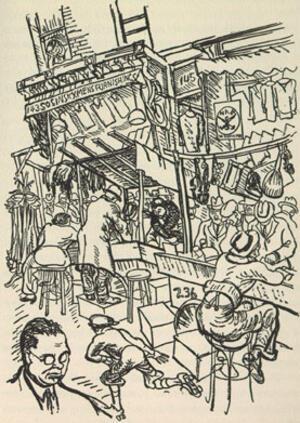Anzia Yezierska was one of more than two million Eastern European Jews who arrived in the United States during a major wave of Jewish immigration from 1880 to 1924, seeking economic opportunity and relief from pogroms and anti-Semitism. Her stories about immigrant life paint a vivid picture of the day-to-day struggles of individuals and families as they faced an environment that was simultaneously brutal and full of possibility. The dialogue in her stories between parents and children, husbands and wives, neighbor and neighbor, Gentiles and Jews, depicts the interpersonal turmoil that was common during this period of American Jewish life.
Anzia Yezierska was born in the 1880s near Warsaw in Poland. Around 1890, her family immigrated to the United States, where they lived in a tenement on the Lower East Side of New York City. Although her parents encouraged her brothers to attend high school and college, she left school after only two years of elementary education and worked in sweatshops to help support her family.
In pursuit of education and independence, Yezierska left home as a teenager and moved into the Clara de Hirsch Home for Working Girls, a residential trade school for young immigrant Eastern European Jews. She found the residence just as stifling as her family's home. Nevertheless, the wealthy German Jewish patrons of the residence recognized her promise and awarded her a four-year scholarship to Columbia's Teachers College where she was required to study the domestic arts. Determined to attain a life of freedom and self-expression, she eventually decided to become a writer.
In a short time, during the 1920s, she became famous for her writing. She was labeled "the sweatshop Cinderella" for having pulled herself from the dreary life of a laborer to become an acclaimed writer. Her fame was short lived. By the 1930s her books fell out of popularity. However, after her death in 1970, her books became well-known once more, as feminists reclaimed lost female writers.
Yezierska's stories explore classic immigrant themes. The older generation feels desperate and helpless to preserve Jewish traditions and ways of life, as they watch their treasured children turn away from them. Meanwhile, the younger generation is eager and impatient to embrace the riches that America has to offer.
Yezierska tells her stories from a woman's point of view, and many are semi-autobiographical. She underscores the injustice that Jewish women experienced working at menial jobs, while Jewish men stayed home and studied classical Jewish texts. She describes the lack of respect and insults that women endured as mothers and wives. Part of what drove Yezierska away from her own family was her quest for equality and respect, which she saw as unattainable given the roles of men and women in traditional Jewish culture at that time.
In our featured story, Children of Loneliness, Yezierska depicts one family that is torn apart when the daughter, Rachel, returns from college having absorbed American culture and values. The mother and father are devastated by their daughter's rejection of them and their immigrant ways. "Oh mother, can't you use a fork?" Rachel complains. When her mother offers her the special latkes that she fried with love on a "stove full of coal like a millionaire," Rachel replies, "I can't stand your fried, greasy stuff." The father screams out at her with dismay and anger. The mother tries to calm the father down, but she herself is distraught. They become caught in a circle of anger and accusations, jabs and counter jabs.
Eventually, Rachel leaves her family, heartbroken, conflicted, and alone. She yearns to live in a world that is refined and beautiful. At the same time, she longs for the comfort and warmth of her parents' home. Peeking through the window one night, but unwilling to knock on the door, she stops to listen to her father as he prays. "Thousands of years of exile, thousands of years of hunger, loneliness and want swept over her as she listened to her father's voice."
Yezierska's Children of Loneliness raises many questions for discussion. How has immigration affected the different generations of our families? In what periods did members of our families first come to America? Has the loneliness and sadness that Yezierska describes been handed down to younger generations? How has assimilation affected the connections we have with our parents and children? How are present day immigrants' experiences similar to or different from those of the characters in Yezierska's stories? What lessons can we learn from Yezierska's Children of Loneliness today?



